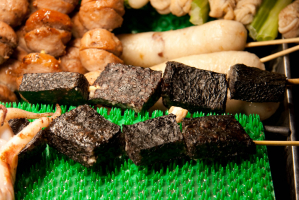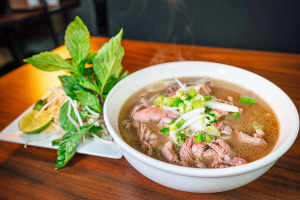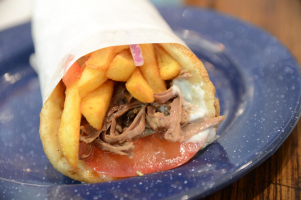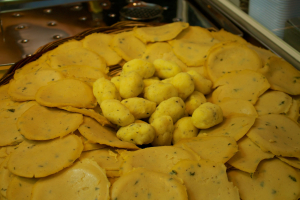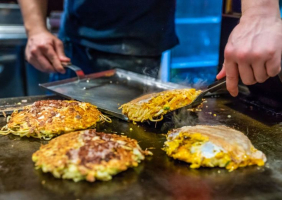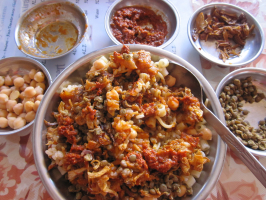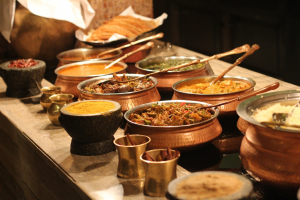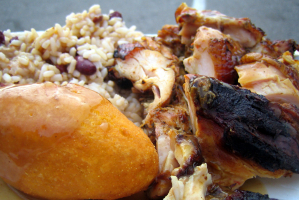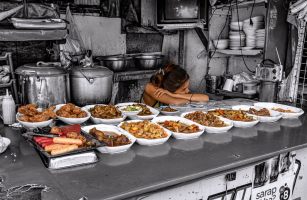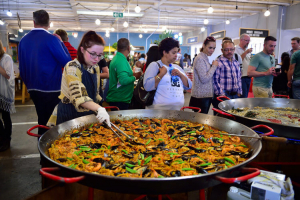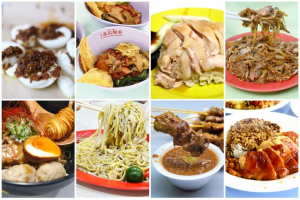Top 10 Most Popular Cambodian Street Foods
Cambodian street foods offer a delightful culinary journey that captivates every palate. With rich flavors and diverse ingredients, they embody the nation's ... read more...vibrant culture. This article explores the unique and mouth-watering world of these street delicacies.
-
Kralan holds the coveted top spot among Cambodian street foods. This traditional snack is a piece of Cambodian culture. Made from sticky rice mixed with beans or peas, the combination is then sweetened with coconut and coconut milk.
What sets Kralan apart is its unique preparation. The mixture is packed into bamboo tubes and slowly roasted over an open flame. This cooking process gives Kralan its characteristic smoky flavor, making it irresistibly delicious.
Kralan isn't a recent culinary invention. It has roots deep in Cambodian history. Villagers in rural Cambodia have been making it for generations. It's a food that tells a story of tradition, resilience, and the passage of recipes from one generation to the next. Over time, Kralan has maintained its authentic essence while adapting to modern tastes.
Its popularity isn't confined to rural areas. In the bustling markets of Phnom Penh and Siem Reap, the inviting aroma of roasting Kralan beckons locals and tourists alike. Many consider it a must-try. That ensures its legacy continues in fast-paced urban settings. Often, sellers have their unique twist by adding to the rich tapestry of Kralan varieties.
Preparing for Kralan is an art. The bamboo tubes filled with the rice mixture must roast to perfection. Too little, and it remains undercooked. Too much, and the smoky flavor becomes overpowering. It requires a keen eye and experience to get it just right. The result? A perfectly cooked, aromatic treat that's both filling and satisfying.
Kralan isn't just an everyday snack. It has its moments of glory during special occasions. In many Cambodian celebrations, Kralan features prominently. It cements a place in the hearts of many.
Different regions have their take on Kralan. Some might add a bit more coconut, while others might roast it a tad longer. These small variations create a delightful array of flavors and textures for the discerning palate.
Key Takeaways
- Origin: Rural Cambodia.
- Flavor Profile: Mildly sweet with a hint of smokiness.
- Ingredients: Sticky rice, beans/peas, coconut.
- Unique Aspect: Cooking inside bamboo tubes imparts a distinct smoky flavor.
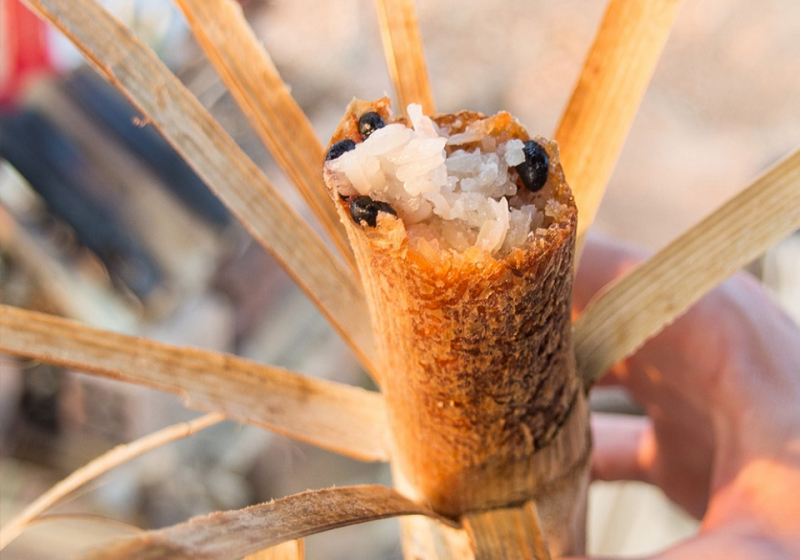
Screenshot of https://askacambodian.net/2015/06/12/kralan-khmer-sticky-rice-in-bamboo/ Video by Chettra Cooking -
Stepping onto the streets of Cambodia in the early morning, a delightful aroma captivates your senses. It's the scent of Bai Sach Chrouk - the second most popular street food. This dish features thinly sliced pork, marinated overnight in a mix of garlic, soy, and coconut milk, then slowly grilled over charcoal. The result is tender, flavorful pork, often served with a side of rice and pickled vegetables.
Bai Sach Chrouk is a morning ritual for many Cambodians. The dish originated from the eastern part of the country. Over time, its appeal spread across almost every corner of Cambodia. Today, vendors set up their stalls as early as 4 am. Ang locals line up, eager to kick start their day with this mouth-watering delicacy.
The grilling process is vital to Bai Sach Chrouk. The slow-cooked method over charcoal imparts a smoky flavor to the marinated pork. Vendors take great pride in their marinade recipes. Some incorporate lemongrass, while others add a hint of chili. These variations give each Bai Sach Chrouk its distinct flavor.
The accompaniments also play a significant role. The pickled vegetables, often cucumber, daikon radish, and carrot, provide a tangy contrast to the sweet and savory pork. The side of rice, lightly fried with garlic. That ensures a balanced meal, both in taste and nutrition.
Bai Sach Chrouk is not just about the taste. It embodies the spirit of Cambodian mornings. As day breaks, streets come alive with the sizzle of grilling pork. Locals share stories, exchange greetings, and enjoy their meal in a communal setting. This dish is an experience, a slice of Cambodian daily life.
Tourists visiting Cambodia quickly fall in love with Bai Sach Chrouk. Many recall the experience of enjoying this dish as one of their most memorable moments. The combination of flavors, the vibrant street-side ambiance, and the warmth of Cambodian hospitality make Bai Sach Chrouk a must-try.
Key Takeaways
- Origin: Eastern Cambodia.
- Flavor Profile: Tender pork with a mix of sweet, savory, and smoky notes.
- Ingredients: Thinly sliced pork, marinated in garlic, soy, and coconut milk.
- Unique Aspect: Slow-grilled over charcoal.
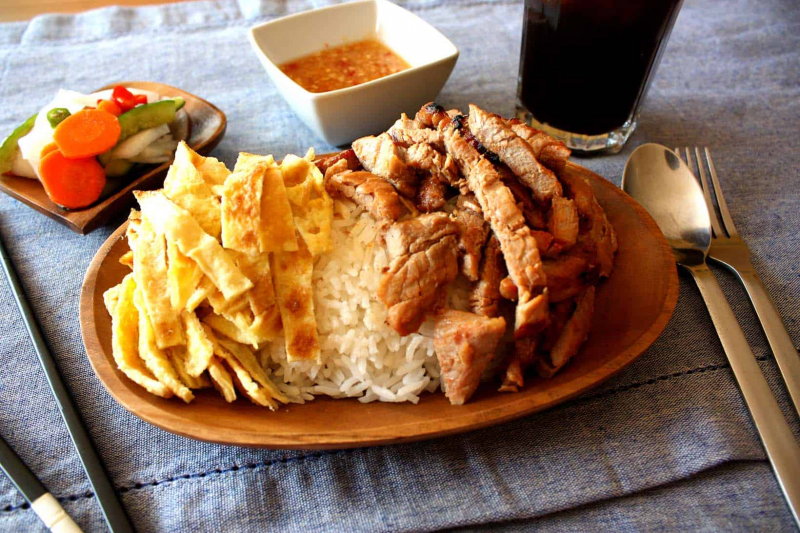
Screenshot of https://www.thidaskitchen.com/cambodian-food/street-food/bai-sach-chrouk/ Video by Moveable Feast -
Num Pang is a beloved sandwich that holds the third spot among the country's street foods. At first glance, it may remind you of the Vietnamese Bánh mì. But dive in, and you'll discover its unique Cambodian twist.
Num Pang boasts a French baguette, a remnant of the French colonial influence in Cambodia. But it's fillings scream Cambodian flavors. There's the juicy pork or chicken, marinated in local spices, then grilled or roasted. Fresh veggies like cucumber, carrots, and radishes add crunch. The chili paste, mayo, or pate spreads elevate the taste by giving it a spicy, creamy punch.
Every Num Pang tells a story. Vendors take pride in their recipes, handed down generations. Some go the extra mile, adding special ingredients like meatballs or egg omelets. These touches make each sandwich stand out. They're not just selling food; they're sharing a piece of their family's legacy.
Num Pang's versatility is its strength. Want a quick breakfast? Grab a Num Pang. Need a fulfilling lunch? This sandwich has you covered. Craving a light evening snack? Num Pang is the answer. Its convenience makes it a favorite among busy city dwellers and tourists on the go.
This sandwich bridges the gap between the old and the new. It carries the weight of Cambodia's colonial past, evident in the French baguette. Yet, its fillings and flavors are undeniably Cambodian.
Stands selling Num Pang dot the streets of Phnom Penh, Siem Reap, and other Cambodian cities. Each vendor has a tale, a secret ingredient, or a unique method. Listening to these stories while biting into a delicious Num Pang is an experience in itself.
Key Takeaways
- Origin: Inspired by French colonial influence, with a Cambodian heart.
- Flavor Profile: Crispy baguette filled with spicy, savory, and fresh ingredients.
- Ingredients: French baguette, grilled meat (often pork or chicken), vegetables, and various spreads.
- Unique Aspect: A blend of French and Cambodian culinary traditions, making each sandwich a history lesson.
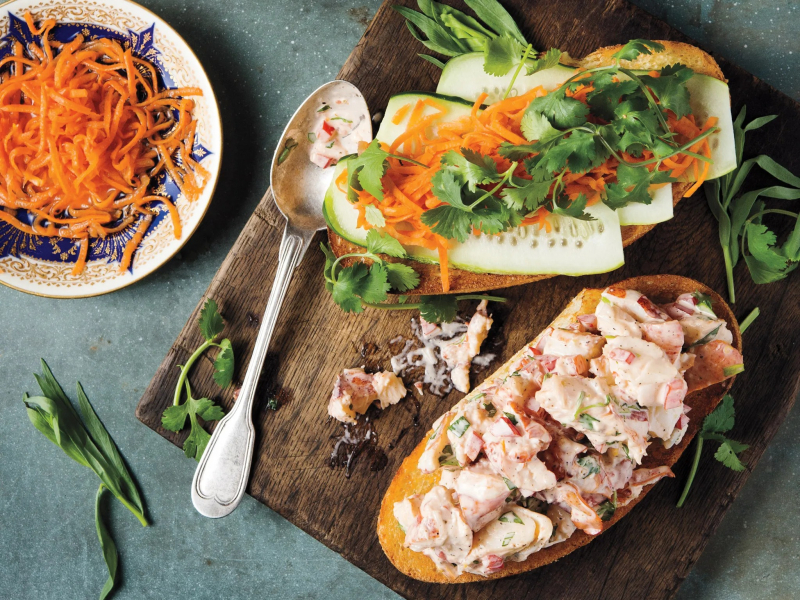
Screenshot of https://grantourismotravels.com/cambodian-num-pang-recipe/ Video by Itchy Feet on the Cheap -
Lort Cha, a scrumptious noodle dish, is the fourth gem in Cambodian street foods. If you're a noodle fan, Lort Cha promises a flavor-packed experience. It’s made from short rice noodles stir-fried with beansprouts, chives, and protein choices like beef or chicken. It offers a delicious medley of textures and flavors.
The magic of Lort Cha lies in its cooking process. It starts with heating the wok to the perfect temperature. Noodles get added, followed by a splash of soy sauce and a dash of fish sauce. The high heat stir-frying ensures the noodles absorb these flavors while retaining a slight chewiness. Top it off with a fried egg, and you have a dish that's hard to resist.
Every bowl of Lort Cha has its own story. The recipe, while seemingly simple, varies from one street vendor to the next. Each has their secret ingredient or method that sets their dish apart. Maybe it's the cut of meat they use or a family sauce recipe passed down for generations. These variations ensure that no two Lort Chas taste exactly the same.
Its versatility is one of its strengths. Whether it's a bustling breakfast or a hearty dinner, Lort Cha fits the bill. Its popularity isn't limited to locals. Many travelers quickly become fans after their first taste. It's an integral part of Cambodia's culinary tourism.
Lort Cha reflects Cambodia's rich history. While the dish itself is uniquely Cambodian, influences from neighboring countries like China and Vietnam are evident. This blending of culinary cultures makes Lort Cha a symbol of regional harmony on a plate.
Vendors often serve Lort Cha with a side of fresh greens. This not only adds a pop of color but also a crunch that contrasts beautifully with the soft noodles. A bowl of this delightful dish is an experience that appeals to all the senses.
Key Takeaways
- Origin: Cambodian streets, with influences from China and Vietnam.
- Flavor Profile: Savory noodles with a hint of umami from soy and fish sauces.
- Ingredients: Short rice noodles, beansprouts, chives, beef or chicken, and condiments.
- Unique Aspect: High heat stir-frying that ensures flavor-packed, perfectly textured noodles.
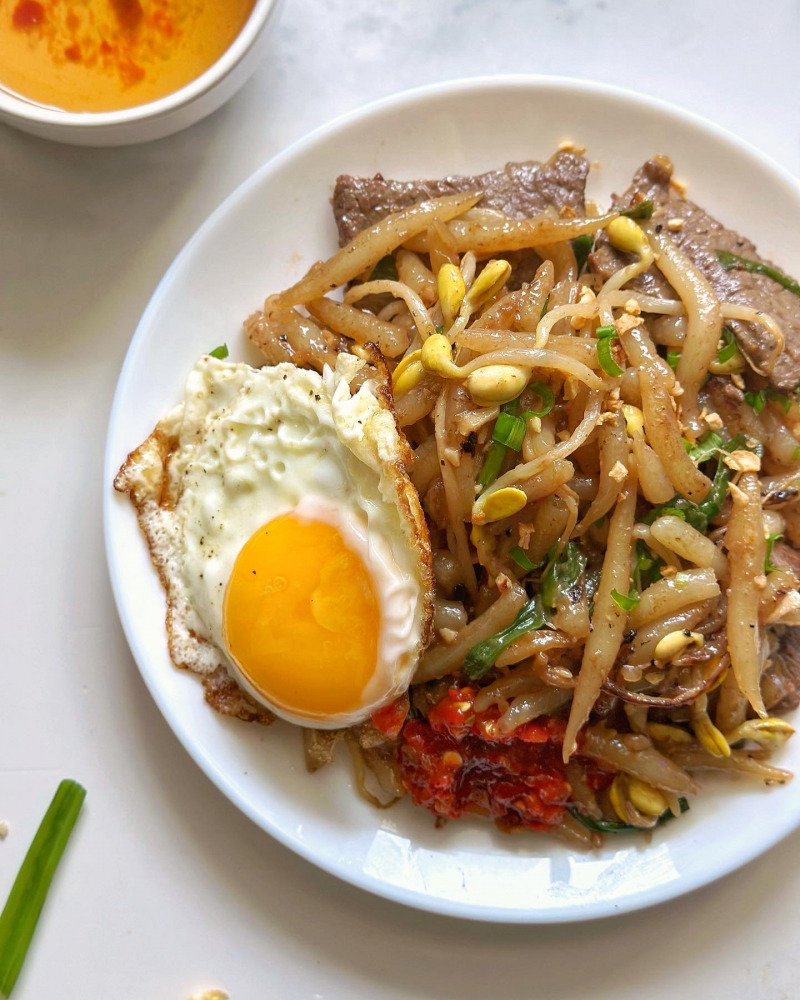
Screenshot of https://www.pete-eats.com/all-recipes/lortchanoodles Video by Street Food TV -
Grilled skewers, a favorite among many, rank fifth in Cambodia's street food lineup. Imagine walking along the streets of Phnom Penh in the evening. The alluring aroma of grilled meat fills the air. That's the magic of Cambodian grilled skewers.
Meat, often chicken, beef, or pork, is marinated in a mix of local herbs and spices. Lemongrass, garlic, and turmeric are just a few that give the skewers their signature taste. Once marinated, the meat is threaded onto bamboo sticks, ready for grilling. The sizzle of the meat on the hot coals is music to many a food lover's ears.
Grilled skewers is not just about the meat. Many vendors offer a variety of options. Think juicy tomatoes, succulent mushrooms, or even tender pieces of fish. The skewers cater to a range of palates, making them a universal favorite.
What makes these skewers stand out is the dipping sauce. A tangy blend of fish sauce, lime juice, garlic, and chili, it adds an extra layer of flavor. Every bite becomes an explosion of taste, with the spicy, sour, and umami flavors dancing on the palate.
Grilled skewers are more than just food. They're a social experience. Locals gather around the grill, chatting and laughing, as they wait for their skewers. It's a communal affair, bringing people together over their love for food.
The versatility of grilled skewers is evident in the numerous variations found across Cambodia. From the bustling markets of Siem Reap to the tranquil streets of Battambang, every region has its unique take. Some might marinate the meat longer, others might use a different blend of spices. These nuances add depth to the culinary journey of grilled skewers in Cambodia.
If you're in Cambodia, make sure to try these skewers. They're not just a treat for the taste buds but also offer a glimpse into the country's rich culinary culture. With every bite, you're savoring a piece of Cambodian history and tradition.
Key Takeaways
- Origin: Cambodian streets, a staple in evening food stalls.
- Flavor Profile: A harmonious mix of herbs and spices with a smoky undertone.
- Ingredients: Meat (chicken, beef, pork), local herbs, bamboo sticks.
- Unique Aspect: The tangy, spicy dipping sauce that elevates the flavor.
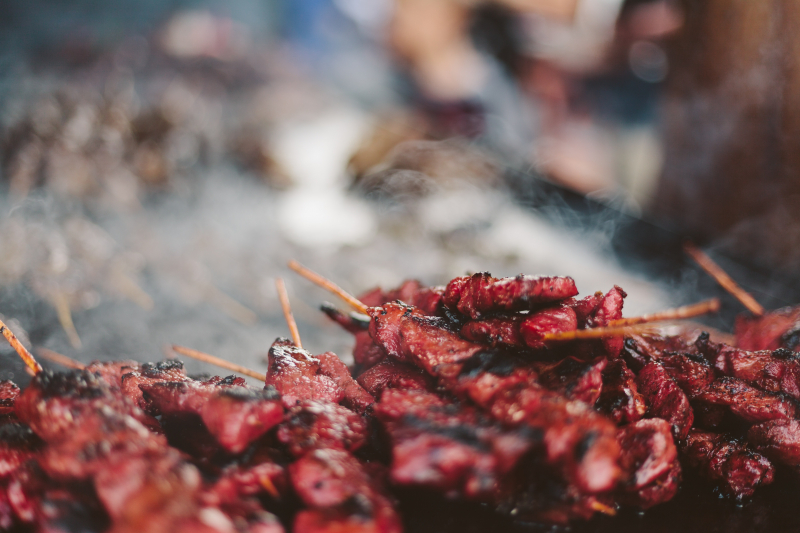
Photo on PxHere https://pxhere.com/sv/photo/1532697 Video by KhornPark88 -
Stepping onto the streets of Cambodia, especially during morning hours, one delightful aroma stands out: Nom Krok. Holding the sixth position in Cambodia's favorite street foods, Nom Krok is a treat not to be missed.
Nom Krok are small, round rice cakes. They're crispy on the outside, soft and fluffy on the inside. The primary ingredient, rice flour, is combined with coconut milk to create the batter. It gives Nom Krok its delicate flavor, a blend of mild sweetness and the rich taste of coconut.
The cooking method is unique. Special clay pans, resembling a muffin tin, are used. They're placed over charcoal, heating up the small rounded pits. The batter is poured into these heated pits. As it cooks, the aroma wafts through the air. This signals another batch of delicious Nom Krok is almost ready.
But what's inside these little cakes? A surprise awaits! Some are filled with minced spring onions or chives, adding a savory twist. Others might contain sweetened mung beans. Every bite is a delightful mix of flavors and textures.
Nom Krok is often enjoyed with a side of fresh, crisp vegetables. Cucumbers, lettuce, or even some herbs might accompany this treat. They provide a refreshing contrast, balancing out the richness of the rice cakes.
In Cambodia, food isn't just about sustenance. It's about community. Nom Krok sellers, with their distinct pans, often attract a crowd. Locals gather around, eagerly waiting for their portion, while engaging in light-hearted chatter.
Every region, from the vibrant streets of Phnom Penh to the serene alleys of Kampot, offers its version of Nom Krok. Some might be a tad sweeter, others more savory. These subtle variations ensure that every Nom Krok experience is unique. When in Cambodia, be sure to try Nom Krok. It's not just a snack. It's an experience, an ode to the country's rich culinary heritage.
Key Takeaways
- Origin: Cambodian morning markets and street corners.
- Flavor Profile: Mildly sweet with a rich coconut undertone.
- Ingredients: Rice flour, coconut milk, fillings like spring onions or mung beans.
- Unique Aspect: The special clay pans used for cooking, giving them their signature shape.
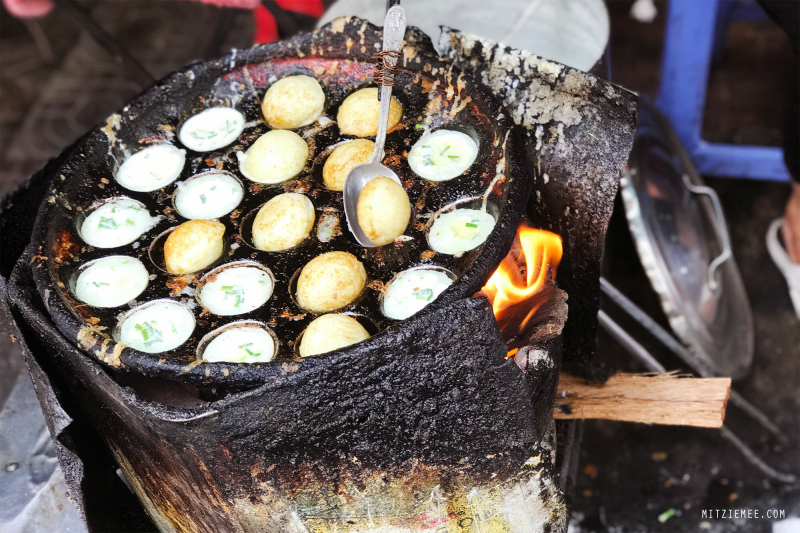
Screenshot of https://mitziemee.com/phnom-penh-street-food-num-krok/ Video by BT Food Story -
The sweltering Cambodian heat calls for a refreshing treat. Enter Coconut Ice Cream, securing the seventh spot in Cambodia's street food hall of fame. This dessert stands as a testament to simplicity meeting deliciousness.
Imagine fresh, creamy coconut milk. It's churned slowly, infused with sweetened palm sugar. The mixture gradually thickens, turning into a velvety ice cream. The texture is divine - creamy, yet light, without the overwhelming richness of regular ice creams.
But what sets Cambodian Coconut Ice Cream apart is its presentation. Vendors don't just scoop it into a regular cone or cup. Instead, it's served in a hollowed-out young coconut shell. The soft coconut flesh still clinging to the inside becomes a part of the treat. Scooping up a bit of ice cream along with the tender coconut flesh is an experience in itself.
Many vendors add a touch of innovation. Toppings vary from sweet corn and roasted peanuts to colorful jellies and fresh tropical fruits. Some even drizzle it with a touch of thick palm syrup or sprinkle it with toasted sesame seeds. Each bite offers a symphony of flavors and textures.
Coconut Ice Cream is more than just a dessert. It's a relief from the tropical heat, a momentary escape. As locals and tourists queue up, the vendor's swift hands work to prepare each serving. It ensures every coconut shell is filled to perfection.
Street corners, bustling markets, or even serene temple compounds, Coconut Ice Cream vendors are easy to spot. Their carts, adorned with fresh coconuts, are a beacon for those seeking respite on a hot day.
The charm of this ice cream isn't just in its flavor. It lies in its authenticity. No fancy machines, no artificial flavors, just the age-old tradition of churning coconut milk with love and patience.
Key Takeaways
- Origin: Street corners and markets across Cambodia.
- Flavor Profile: Creamy with the natural sweetness of coconut and palm sugar.
- Ingredients: Coconut milk, palm sugar, and various toppings.
- Unique Aspect: Served in a hollowed-out young coconut shell, blending ice cream with soft coconut flesh.
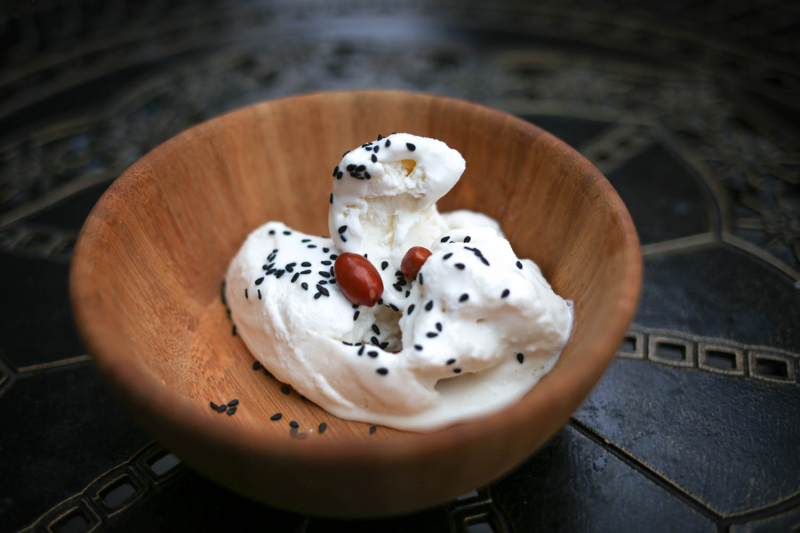
Screenshot of https://lostplate.com/recipes/karem-no-machine-coconut-ice-cream-froyo-recipe/ Video by Street Food Time -
When wandering the bustling streets of Cambodia, a sweet aroma often beckons the hungry traveler. It's the scent of Chet Chien, clinching the eighth position in our list of renowned Cambodian street foods. Deep-fried to perfection, these banana fritters are a joyous treat for both locals and tourists.
The recipe starts with ripe bananas. Not overly ripe, but just perfect. Vendors slice them into thick pieces, ensuring each slice is uniform. These banana slices are then dipped into a carefully prepared rice flour batter. The batter is the secret behind the crispy exterior of Chet Chien. It's seasoned subtly, with a hint of palm sugar and a touch of salt. That perfectly balances the natural sweetness of the bananas.
Then comes the frying. Pots of hot oil bubble away as vendors drop in the battered bananas. They sizzle and dance, turning a beautiful golden brown. Once cooked to perfection, they're scooped out and allowed to drain. They're crispy, not oily.
Chet Chien offers an experience in every bite. The outside is golden and crispy, while the inside remains soft and lusciously sweet. As one bites into a fritter, the crunch of the crust gives way to the creamy texture of the banana. It’s a delightful contrast.
The best way to enjoy Chet Chien is fresh out of the fryer. Many vendors serve them sprinkled with a touch of powdered sugar or a drizzle of palm syrup. Some even offer a side of creamy coconut milk for dipping. It’s the way to elevate the flavors to a whole new level.
This treat is ubiquitous across Cambodian markets and street corners. During evening hours, as the sun sets, Chet Chien stalls light up. It draws in crowds with the promise of a warm, sweet treat. It's a snack that bridges the gap between the young and old, loved by all and sundry.
Key Takeaways
- Origin: Across Cambodia's markets and streets.
- Flavor Profile: Crispy exterior with a sweet and soft banana interior.
- Ingredients: Ripe bananas, rice flour batter, palm sugar.
- Unique Aspect: The contrast between the crunchy crust and the creamy banana filling.

Screenshot of https://compassandfork.com/recipe/quick-easy-golden-fried-banana-fritters-are-awesome/ Video by Travel Thirsty -
For those with a bold palate, snails take a revered ninth spot. This isn't your everyday snack. It's a deep dive into Cambodia's age-old traditions and flavors by bridging the gap between past and present.
Snails have been a part of the Cambodian diet for centuries. They thrive in the country's wetlands and rice paddies. Local farmers harvest them during the rainy season, ensuring a fresh supply for the bustling markets. Once harvested, they're thoroughly cleaned, a crucial step to ensure the snails are safe to eat.
The preparation methods vary, but one stands out: the fragrant and spicy snail soup. Snails are boiled to tender perfection. The broth is rich, infused with local herbs, lemongrass, kaffir lime leaves, and galangal. A hint of chili gives it a fiery kick, appealing to those who love some heat.
For those less keen on soup, there's another popular option. Snails are stir-fried with aromatic herbs, garlic, and a splash of fish sauce. This method gives them a slightly crispy exterior while keeping the insides juicy. When perfectly done, they offer a delightful play of textures in the mouth.
While the flavor of snails is somewhat earthy, it's their texture that truly stands out. Soft, slightly chewy, and incredibly succulent. It's an experience, one that gets better with every bite.
Venture to any local market in Cambodia, and you'll find vendors selling bags of these delicacies. They're often enjoyed with a cold beer, making for a perfect evening snack. Some stalls even offer a unique twist. They incorporate modern flavors, but the essence remains rooted in tradition.
Trying snails might be a leap for some, especially those unfamiliar with it. But once past the initial hesitation, it's a taste that lingers. It's a testament to Cambodia's rich culinary diversity, where even the humble snail is transformed into a gastronomic delight.
Key Takeaways
- Origin: Thrive in Cambodia's wetlands and rice paddies.
- Flavor Profile: Earthy taste, soft and slightly chewy texture.
- Ingredients: Freshwater snails, local herbs, chili, fish sauce.
- Unique Aspect: The contrast between the earthy flavor and the aromatic spices.
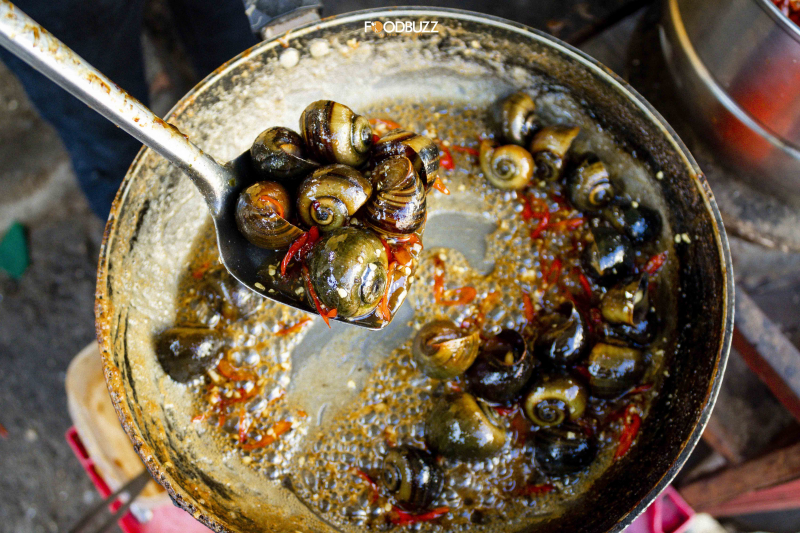
Screenshot of https://foodbuzz.site/en/food-review/khchaw-srei-phloh-eng Video by Street Food TV -
When summer hits Cambodia, the markets overflow with the rich yellow of ripe mangoes. Amidst the myriad of ways to relish these mangoes, there's one dish that stands out distinctly - Bey Dom Neib. This dish celebrates the harmonious fusion of sweet, succulent mango slices and the creamy texture of coconut-infused sticky rice.
The preparation of Bey Dom Neib showcases the meticulous nature of Cambodian culinary practices. The sticky rice undergoes a thorough soaking process, spanning several hours. This ensures every grain softens to perfection. After soaking, the rice gets steamed. As steam rises, the grains swell up. It absorbs moisture and achieving that signature sticky consistency.
But that's not where the magic ends. Warm steamed rice is then married to a mix of rich coconut milk and sugar. This infusion transforms the humble sticky rice into a sweet and creamy delight. As it cools down, the rice, dense and rich, often gets shaped into enticing mounds or delicate balls. Some chefs even place them in decorative bowls, adding an aesthetic appeal.
Now, the stage is set for the star – the mango. Only the ripest, sweetest mangoes make the cut. They're peeled and sliced, their vibrant yellow contrasting beautifully with the creamy white of the rice. When these two come together on a plate, it's a match made in culinary heaven.
Eating Bey Dom Neib is an experience in itself. The first bite introduces you to the sweet texture of the rice and the juicy freshness of the mango slice. As these flavors play on your palate, it becomes clear why this dish is a summertime favorite. In street stalls, where vendors serve them fresh, often garnishing with a sprinkle of sesame seeds or even a drizzle of extra coconut milk.
Key Takeaways:
- Origin: Traditional Cambodian dessert
- Flavor Profile: Sweet and creamy, complemented by the freshness of ripe mangoes.
- Ingredients: Sticky rice, coconut milk, sugar, ripe mangoes.
- Unique Aspect: The harmonious blend of mangoes and coconut-infused sticky rice.
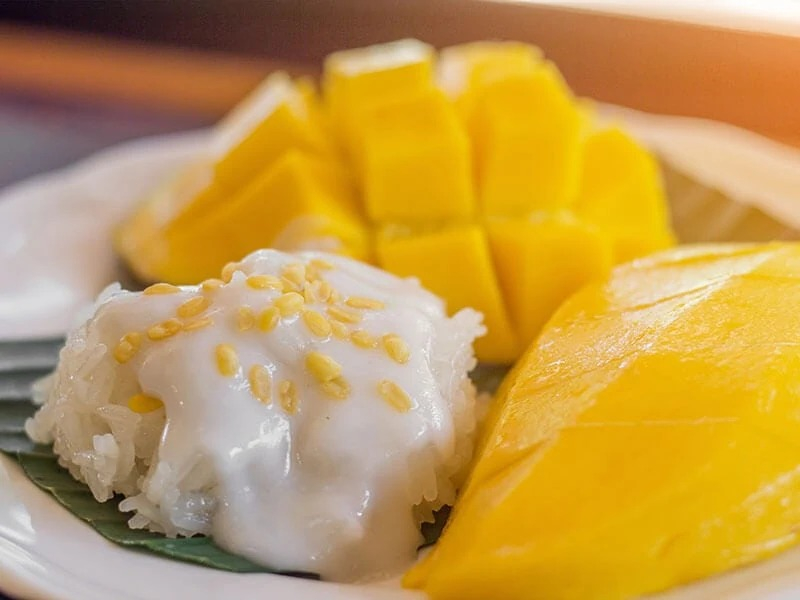
Screenshot of https://foodfuntravel.com/cambodian-cuisine-discover-the-most-popular-dishes-drinks/ 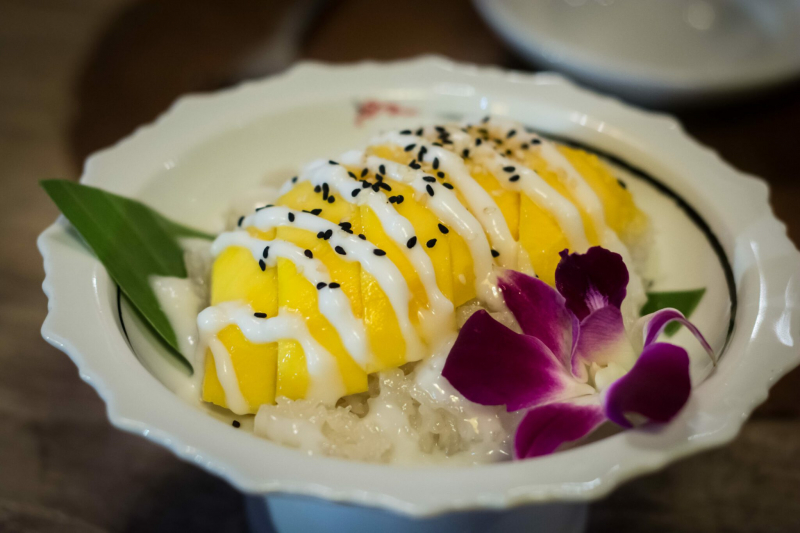
Screenshot of https://foodfuntravel.com/cambodian-cuisine-discover-the-most-popular-dishes-drinks/












